
If digital transformation involves more than installing technology, what does digital transformation actually mean?
- According to Stanford University, digital transformation is more than a minor modification to business processes. It’s transformational because it’s about radically rethinking your business model and fundamentally changing how you do business.
- Salesforce defines digital transformation as using digital technologies to create new or modify existing business processes, organizational culture, and customer experiences to meet changing business and market requirements. The reimagining of business in the digital age is digital transformation.
- Gartner describes digital transformation as exploiting digital technologies and supporting capabilities to create a robust new digital business model.
These definitions have an essential element in common: digital transformation touches the entire organization and the company’s business model. It comprises much more than technology because it requires a shift in how people in the organization work and, ultimately, a cultural change. This is what makes successful digital transformation tricky.
The difference between digitalization and digital transformation is that the former applies technology to existing business processes and workflows, while the latter is about repurposing these processes and workflows in a new digital way.
Understanding the distinctions between
digital transformation, digitization and digitalization
There needs to be more clarity about the difference between digital transformation, digitization and digitalization. Often, these terms are used interchangeably, but they mean different things—and it is not a matter of semantics. The benefits linked to each vary significantly.
Digitization is the process of changing from analog to digital format. It is a classic example of converting handwritten text into digital form. Unlike digital transformation, digitization focuses on the information alone without changing the process, which becomes automated. Digitization helps by increasing productivity and efficiency while decreasing costs.
Digitalization leverages digital technologies to change a business model and create new revenue-producing and value-producing opportunities. In other words, it’s moving to a digital business. With digitalization, existing processes and business models have been optimized, thanks to the ability to leverage digital data in a specific way through technology. An example of digitalization is uploading a PDF document (the handwritten text that was converted into digital form in the previous example) from a laptop’s hard drive to the cloud so it can be shared with other teams in the organization to enable them to analyze the data.
Digital transformation requires both digitization and digitalization. The critical distinctive element is the transformation: how to create a long-term competitive advantage to be successful and retain importance in the market.
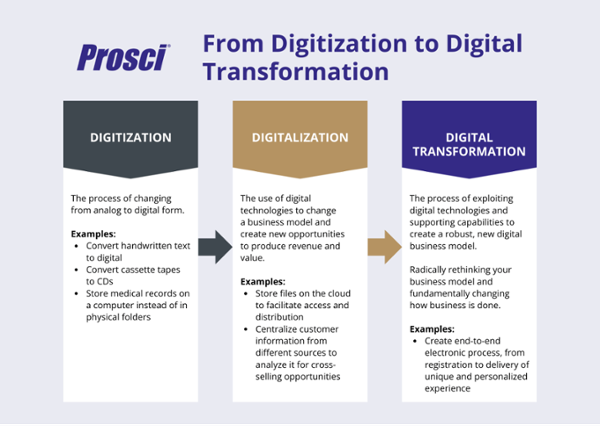
Digital transformation is not about digitizing what companies already do or applying technology to the existing business to achieve the change (digitalization). It is about redefining how they create value and differentiate themselves from the competition by providing unique and personalized customer experiences. Digital transformation is made possible by the increased pace of inventions and by how these new technologies are combined to create new capabilities that exceed what could be possible when deployed separately.
"Digital transformation is an ongoing process of changing the way you do business. It requires foundational investments in skills, projects, infrastructure and, often, in cleaning up IT systems. It requires mixing people, machines and business processes, with all the messiness that it entails."
—Professor George F. Westerman, MIT Sloan School of Management
Key challenges in digital transformation
Many executives think that they are doing digital transformation by focusing on digitization or digitalization—here lies the challenge. Automating existing processes and workflows contributes to cost reduction but does not radically transform the business model and how business is done. Hence, this is one of the reasons why organizations do not achieve the expected ROI. They often envision that by implementing one or several digitization projects, they will achieve digital transformation. That’s not enough. Digital transformation requires changes to the culture and practices within the organization.
A People-Centric Approach
to the Value of Digital Transformation
Digital transformation is more likely to succeed when organizations adopt a people-focused approach.

The following key metrics assess the impact on team performance and customer satisfaction:
- Return on Investment (ROI): Essential for gauging how technology, training and staffing investments impact revenue and determine the effectiveness of digital transformation strategies.
- Time to Market: A vital metric measuring how swiftly digital solutions are delivered indicates a company's agility and competitive edge.
- Person Hours and Dollars to Working Prototype: This measures development efficiency, balancing speed and cost-effectiveness against technical debt risks.
- Usage Key Performance Indicators (KPIs): Monitors digital initiatives' adoption and engagement levels, offering insight into user acceptance.
- Productivity KPIs: Evaluate the availability and effectiveness of digital resources, skills and employee training, ensuring teams are equipped for digital transformation goals.
These metrics provide an integrated view of the effects of digital transformation, in line with the Prosci focus on people-centered, outcome-oriented approaches.
Expert insights on ROI:
As digitalization reshapes business, ROI is increasingly defined by how well IT leaders align technology with business value.
- Peter Sondergaard, the former Executive VP of Gartner, highlights a shift in the landscape for IT professionals on ROI:
"Digitalization is increasing the demand for IT leaders to understand how technology underpins business processes. A third of IT workers in digital businesses will require a working knowledge of the principles of business to advance." - Satya Nadella, CEO of Microsoft, emphasizes that customer value is the main way to measure how successful an innovation is.
"The true measure of our innovation is the value we create for our customers, and by that measure, we’re accelerating."
Digital transformation success relies on IT melding technology with business goals to enhance customer experiences. This customer value is the real measure of your digital ROI.
The central role of culture in digital transformation
When I discuss digital transformation with clients, it is not unusual to hear that they concentrate mainly—or solely—on the importance of designing, developing, and deploying new technology, such as artificial intelligence (AI), Internet of Things (IoT), robotics, 3D printing, and BlockChain. Technology is undoubtedly essential, but it is only one side of the equation. Having state-of-the-art systems, software, and platforms is insufficient for a successful digital transformation.
Experts on cultural change in DTM
Digital transformation management is as much about changing company culture as it is about adopting new technologies. Leaders in the field echo this sentiment:
- Satya Nadella (CEO, Microsoft) on culture:
“Our industry does not respect tradition. It only respects innovation. The first step to building the right company culture is to have a growth mindset.” Nadella's stance is clear—a culture that embraces learning and continuous improvement is crucial in a landscape driven by constant innovation. - Linda Boff (CMO, GE) on culture:
“Becoming a digital industrial company is a big cultural change for us. But culture is the hardest part. It’s easy to go buy technology off the shelf. The hard part is deciding what you want to be.” Boff highlights the challenge of defining a company's identity in the digital age—a task that demands intentional cultural evolution.
According to these leaders, this demands a culture open to trying new things, learning, and quickly adapting. Such a culture is key to making the most of digital transformation for ongoing growth and innovation.
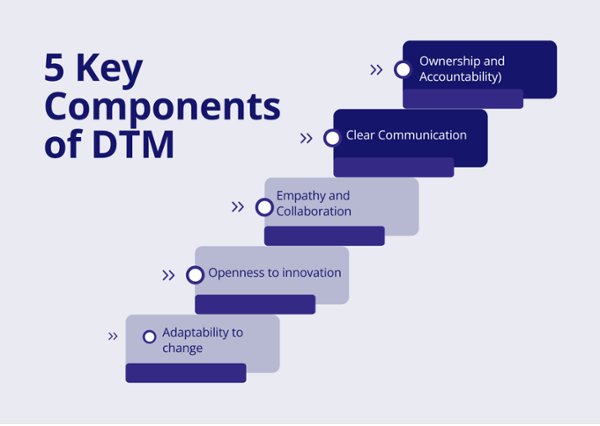
Components of DTM
The success of digital transformation management (DTM) hinges on a series of well-defined, strategic steps.
- Adaptability to Change: Embrace change as an opportunity. Prosci champions a culture of agility, ensuring your organization can navigate the digital tide's ebb and flow with grace and resilience.
- Openness to Innovation: Innovation is encouraged—it's sought after. We advocate for a proactive stance on innovation, inviting ideas that propel you forward and keep you at the forefront of your industry.
- Empathy and Collaboration: At Prosci, empathy is more than a value—it's a practice. It's about understanding and collaborating across all levels of the organization to ensure that every transition is smooth and considerate of the human element.
- Clear Communication: Clarity is king. Our approach to communication is straightforward and transparent, keeping everyone from stakeholders to staff aligned with the transformation vision and their roles within it.
- Ownership and Accountability: We believe in empowering individuals to take charge of their contributions. When people are accountable for their slice of the transformation, they drive change with a sense of purpose and pride.
Success requires focusing on the organizational changes needed to leverage technology's opportunities. To take advantage of the power of technology, companies need to support the individuals impacted by the change so they can adopt and use the new technology, change their mindset, and adopt different critical behaviors required to deliver new products, services, and customer experiences. This means that leaders must direct their attention to the people side of change.
The Project Manager’s Guide to Integrating Change Management in the Digital Age
The disciplines of change management and project management each have a role to play in digital transformations, but effectively integrating the two disciplines enables the project's success and, ultimately, its return on investment (ROI). The Prosci Unified Value Proposition illustrates how this works.
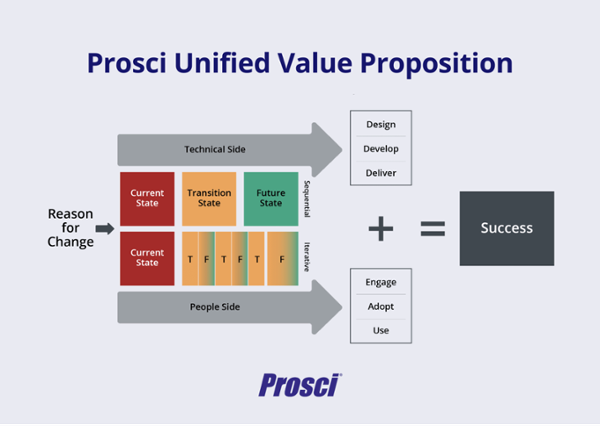
Typically, when dealing with what they think is digital transformation, organization leaders focus on the technical side or designing, developing, and delivering the solution (e.g., the new app or uploading files on the cloud). They often believe that because the technical side is in place, they will automatically see significant improvements to the bottom line.
However, even if the solution is state-of-the-art, more is needed. The company must also focus on the people side of change with a repeatable, scalable approach. Impacted employees need to be supported in their personal change journey when adopting the new way of work and doing it proficiently. Specific focus must be put on the cultural change and the customer-centric experience.
Embrace People-Centric Change With
Digital Transformation
The Prosci Methodology enables organizations to manage change successfully by supporting the impacted employees in their ADKAR journeys and facilitating organizational change through the Prosci 3-Phase Process.
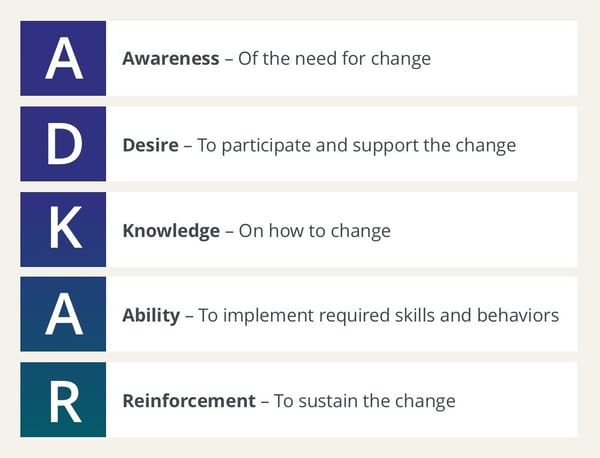
It’s best to incorporate change management during the planning stages when starting a digital transformation. If your project is in progress or fully implemented, change management can still help. Here's what you can do next to gain momentum with the people side of change and achieve quick wins.
1. Assess whether your organization is focusing on digitization, digitalization or digital transformation
It's also critical to assess whether the focus is the true intent of the executives. If you realize there is a mismatch between the organization’s leaders' understanding of these concepts and what they entail, aim to educate the organization and show the consequences of incorrectly applying them. Support the leaders in reassessing their objectives and expectations.
2. Balancing tech and people in digital transformation
If this is your situation, prepare a solid case for change management explaining why the people side of change is key when successfully implementing digital transformation. It is not only about technology—it is also about the people.
3. Integrate project management and change management
It is essential to focus on supporting impacted individuals in adopting and using the solution and changing their mindset and critical behaviors linked to the new customer experience offered by the organization in which they operate. Integrating project management and change management enables you to accomplish this.
Ensure your digital upgrades work well for your team. It leads to smoother operations and happier employees.
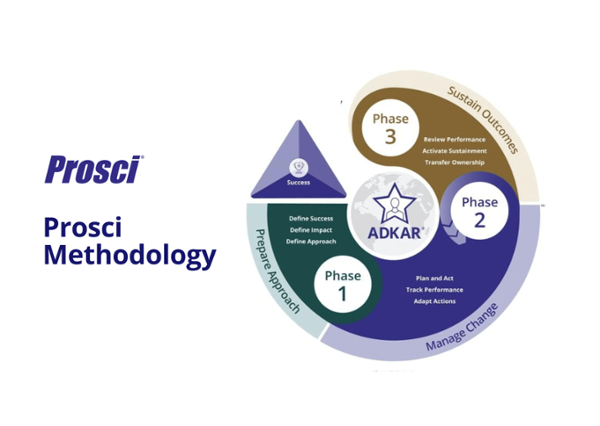
Frequently Asked Questions:
1. What does a chief digital officer do?
As a strategic leader, the Chief Digital Officer (CDO) guides organizations into the digital era. This role involves shaping the digital vision, orchestrating technology to meet business goals, and leading a cultural shift toward digital adoption. The CDO ensures digital practices enhance performance and customer service, making them pivotal in the organization's digital transformation journey.
2. How do you engage employees in digital transformation?
Engaging employees in digital transformation involves communicating the benefits for their roles and the overall company. Essential steps include providing thorough training, involving staff in planning, and maintaining open communication. By valuing employee feedback, demonstrate how digital enhancements can streamline and improve their work efficiency.
3. How do you structure a digital transformation team?
Structuring a digital transformation team requires diverse IT, change management, and business strategy skills. Key to this structure is appointing a Chief Digital Officer (CDO) who reports directly to the CEO or another executive board member. This leader oversees the transformation, ensuring alignment with the organization's vision and goals. The team, led by the CDO, must be flexible and capable of addressing both immediate objectives and long-term strategic aims.
Remember, digital transformation management combines tech with the human touch for broader growth. Keep your people at the forefront, and if you need more guidance, reach out to Prosci for expert advice to advance your efforts.
Bridge Digital Transformation With Effective Change Leadership
Navigating digital transformation management extends to new technology and encompasses reshaping systems, company culture, and processes.
A people-centric approach, as championed by Prosci, prioritizes your team's needs and perspectives.
Each step towards digital integration should enhance value and encourage broader adoption, reflecting a holistic transformation that aligns technology with human-driven change.
Are you ready to take the next step in effectively managing your digital transformation? To learn more, contact Prosci for real-world advisory services that drive results.




